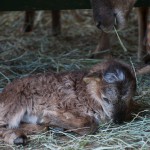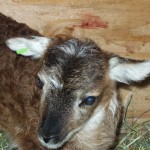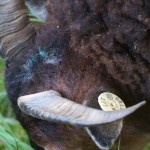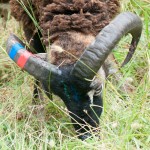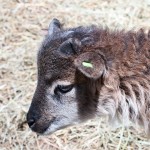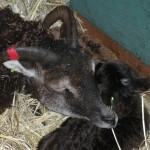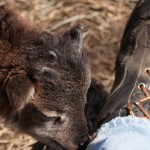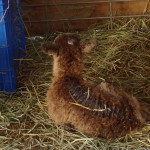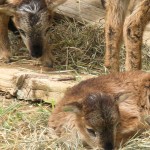White spotting in Soay sheep: twinks and carrier status
The second in a series of posts about white spotting. The first addressed a series of questions about the frequency of white spotting in Soay sheep, whether skewbald is “normal” in Soay, and whether breeders should try to get more or less white spotting in their flocks.
Apology and Caution: following contains excessive amounts of data and terminology. Proceed at your own risk!
Many of my readers are already familiar with the phenomenon of white spotting: about ten per cent of British Soay sheep in North America exhibit patches of white fleece, commonly on the head and face, occasionally on the body and legs or feet. White spotting is caused by a recessive allele (‘s’) at the White Spotting locus (‘S’). The simple rules of inheritance tell us that sheep expressing this recessive trait — those showing patches of white — are ‘ss’ homozygotes and that plain brown sheep are either heterozygous carriers (‘Ss’) or homozygous for the more common dominant allele (‘SS’). “SS” sheep have no copies of the white-spotting gene.
This post is not about sheep showing white spots or about their plain brown counterparts. They have their own posts. But in the real world lambs show up that do not fit neatly into the tidy brown or white-spotted categories of textbook genetics. This post is devoted to the untidy lambs, the ones somewhere in between white-spotted and plain brown.
Roughly ten per cent of our lambs show a cluster of white hairs, described informally as “twinks” or “wisps,” on the tops of their heads — much less than a white spot but at the same time more than nothing. This phenotype is most common when one or both of the parents was spotted, but it also happens when neither parent displays any white at all.
As with many other Soay breeders, accurate characterization of our animals’ genetics traits is important to us. We grapple with how to classify lambs that have only twinks, but no actual spots or patches of white. We know white-spotted lambs are homozygous (ss); they have two copies of the gene; their phenotype is easy. But what about lambs with only a twink? Are they also homozygous or are they heterozygous (Ss), carrying only one copy of the gene? How big does the twink have to be before we conclude that the lamb must be a homozygote (ss)? And if the lamb has no white at all, not even a few white hairs on the top of its head (a twink), can we say with any confidence that the lamb is not a carrier of white-spotting (Ss)?
What’s not to love about this terminology: “wisps” and “twinks”? It turns out there also is a conventional term for a phenomenon like twinks, a term broadly understood by geneticists — “leaky.” For example, when describing twinks and especially the fact that they sometimes disappear, a geneticist might adopt an air of great self-importance, stroke his or her chin, and pronounce, “the trait is recessive but sometimes a carrier can be a little leaky.” Okay, back to business.
Unfortunately, our lamb data does not provide the answer on where to draw the line in classifying between carrier and homozygote, and none of our sheep books provide an answer, either.
The question is especially vexing because sometimes the twinks fade and eventually disappear altogether. Steve has tended to label a lamb as a carrier, heterozygous for white spotting (Ss) if there were no discernable spots of white, but only a dozen or two closely-spaced white hairs on its head sprinkled among brown hair.
He generally has reserved the designation of homozygous (“white spotted” or “ss”) for animals with at least a white spot or patch somewhere on their bodies that is at least the size of a quarter — big enough that there are no brown hairs interspersed with the white.
If you are saying to yourself, “pretty fuzzy thinking for a professional geneticist,” you are not alone. I have become spoiled by the privilege of serving up almost any genetics-related question around the dinner table and getting a solid answer back. But it seems none of Steve’s graduate seminars included field work in labeling the white-spotted status of a bunch of ancient, primitive, nearly-feral sheep from remote islands between Scotland and Greenland. Oh well. What we do have is a heap of data, as you know, and we dug into it hoping to see patterns in the numbers that reveal a clue or two about what’s going on with carrier status in Soay sheep.
A brief refresher: it is straightforward Mendelian genetics that if two white-spotted sheep are crossed, all the lambs should be white-spotted. If a white-spotted sheep is bred to a carrier, there should be a 50% chance that a given lamb will be white spotted and 50% chance it will be a carrier. And if both parents are neither white spotted nor carriers, the lamb should be neither white spotted nor a a carrier. So far, so good. But there are other permutations. In particular, what is the genetic basis, if any, of those twinks? Let’s look at the numbers.
Here is the raw data on our British Soay sheep production.
[table th=”0″ colalign=”center|center|center|center|center”]
Parents [attr rowspan=”2″ style=”vertical-align: middle; font-weight: bold”],Lambs produced [attr colspan=”4″ style=”font-weight: bold;”]
White, Twink, None, Total
White x White, 0, 0, 0, 0
White x Twink, 7 (47%), 2 (13%), 6 (40%), 15
White x None, 14 (18%), 21 (28%), 41 (54%), 76
Twink x Twink, 1 (14%), 2 (29%), 4 (57%), 7
Twink x None, 7 (10%), 4 (6%), 56 (84%), 67
None x None, 11 (4.6%), 14 (5.9%), 214 (90%), 239
Totals, 40 (10%), 43 (11%), 321 (80%), 404
[/table]
The first and most obvious conclusion from these data is that we are getting about 10% spotting. This rate compares to the percentage of white-spotted lambs in the overall North American-based cohort of British Soay sheep. More to the point, it is in the expected range based on the composition of our foundation flock.
However, our rate of lambs showing white-spotting, taken alone, is no help in sorting out either the dividing line between homozygous/heterozygous or what a twink means in the first place. To address these questions, we need to look deeper into the range of breeding pairs and what each group has produced. For example, we know that a lamb will only be white-spotted if it has inherited one copy of the white-spotting gene from each parent. For 32 of our white-spotted lambs, (14 + 7 + 11) one of the parents showed no white but must have been (twink-less) a heterozygous carrier. Therefore, at least in some cases, carriers do not have twinks.
The data also tell us that Soay sheep with only a twink are not homozygous for white spotting, i.e., animals with only a twink do not have two copies of the gene. If the animal did have two copies of the gene, white and twink would be equivalent genetically, constituting only one genotype (ss). And consequently, our 6 “no-white” lambs from white-by-twink breedings and the 4 no-white lambs from twink-by-twink breedings would have been white-spotted or had twinks. In other words, if Soay sheep with only a twink were homozygotes (ss), when bred to another twink or a white-spotted animal their offspring would all show either white patches or twinks. And that’s not what our British Soay sheep have produced.
Are you still with me? Let’s see, what else do we know from these data? Well, here’s a fun one. We have had several skewbalds from breedings that did not include a white-spotted parent (much less both parents), which means a breeder does not necessarily need to have any white-spotted Soay sheep in order to get an occasional skewbald lamb. So do not be surprised if you come out one spring morning and find a skewbald lamb out of a plain-brown-by-plain brown mating. When Steve first told me he thought there might be additional genes involved in skewbald, he had not even looked at this data. When I showed him the list of all the skewbald lambs’ parentage, he just took another long sip of beer. I plan to show this data through pictures in another post, so please stay tuned.
After we combed through the lambing data, we looked for corroborating evidence for the conclusions and observations you just read about. For one of them — a Soay sheep can carry a copy of the white gene without any visual evidence, not even a twink — we can back into the same conclusion by looking at a lamb’s parentage but totally ignoring what the lamb looks like. If one of a lamb’s parents is white-spotted (ss), the lamb must necessarily be a carrier because it got one copy of the gene from its white parent. We have 47 lambs with neither white spotting nor twinks but who nonetheless are obligate carriers (Ss) due to the fact that one the parents is white-spotted (ss). Here is more evidence that a sheep with no visual white can be a carrier of spotting.
When we look again at our plain brown lambs and what they later produced as adults, we find similar supporting data. Again, a white-spotted lamb must have gotten one copy of the gene from each parent. Fifteen of our spotted lambs have at least one parent showing no white or twink, yet the parent must be a carrier in order to have passed on its one white-spotting gene to the lamb. Put another way, all the parents of white-spotted lambs are either white-spotted themselves or they are proven carriers.
What we cannot conclude simply from looking at these data is whether every Soay sheep with a twink necessarily is heterozygous (i.e., a carrier) for white spotting, or whether a Soay sheep with just a twink might not carry white spotting at all. The good news is that even with more data, which would mean producing even more lambs, we would not know the answer. Thank goodness for small favors! The bad news is that Steve tells me there may be a way to test the hypothesis using formulas that are guaranteed to produce brain cramps in even the most dedicated budding geneticist (that’s me). I think I will face this one another day.
For now …
